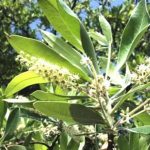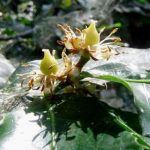TREE LIFE
January 1984
MASHONALAND CALENDAR
Tuesday January 3rd : Botanic Garden Walk Meet in the Car Park at 1645 for 1700 hours.
Sunday January 15th : A visit to Audley Ed Darwendale, the home of Trevor Gordon. As mentioned last month Trevor is a very enthusiastic member of long standing and a past Chairman who is exceptionally knowledgeable about indigenous trees and has planted a large number on the farm. Indications are that we will be joined by some of our Ayrshire members. Perhaps some Chegutu members may be tempted to attend as well. A bus has been arranged which will leave Monomatapa Car Park at 0900 hours. Fare $7.50
MATABELELAND CALENDAR
Sunday January 15th : Our usual day is the first Sunday of the month but since that it is New Year’s Day and the second Sunday is the regular Ornithological Society day, we decided on the 1th. Meet at the home of Val Deas at 0830, 330 Crouch Road, off Essexvale Road, opposite Leeside.
BOTANIC GARDEN WALK, 6TH DECEMBER 1983
Tom Muller introduced us to the family EUPHORBIACEAE by showing the diversity within the genus Euphorbia. Searching the lawns we found a small weed that had escaped the weed killer and contrasted this creeping plant with the large candelabra E. fortissima of the Zambezi Valley. In tying the families together one needs to consider the conservative, i.e. unchanging, features with the flower and fruit because many of the superficial characters have undergone extreme modifications. The EUPHORBIACEAE are pooled into one group by the separate male and female flowers which may or may not be on the same tree. Many of the flowers have lost their petals so it can be confusing to find the family arranged after the POLYGALACEAE with such showy petals.
E. griseola subsp. mashonica is often a low succulent but anyone on the trip to Trevor Cox’s farm will remember the magnificent trees on the kopje. Tom showed us how the leaves have been modified into spines. The stem is thus the main photosynthetic structure, as a result it is often flattened and winged resembling a leaf blade.
An unusual feature in the dicotyledons which are usually arranged in 4’s or 5’s is often seen in the EUPHORBIACEAE; a three lobed fruit capsule. This occurs on Phyllanthus inflatus, a forest understory inhabitant of Mt. Selinda, where we also noted two different branches characteristic of the genus. The simple alternate leaves are arranged on a short deciduous branch that closely resembles a compound leaf. The flowering branchlets were laden with the six segmented fruit. These side branches are arranged on a thicker stem that continues growth. Later we passed P. reticulata and were once again overpowered with the potato smell characteristic of the lowveld valleys.
Another family feature is the presence of stipules at the base of the leaf stalk; these we saw again in Sapium ellipticum which also has another common EUPHORBIACEAE feature, a milky latex. Once again the simple, alternate leaves. This medium altitude tree of the Vumba and Eastern mountains usually grows to 30 m. In contrast to other families we have studied recently which have simple, alternate leaves such as the APOCYNACEAE and SAPOTACEAE, the leaves of EUPHORBIACEAE are often not entire. The margin of S. ellipticum is scalloped as it is in the rare smaller leaved S. interregnum, the last plant we examined on this walk. This S.E. Zimbabwean tree is common in Natal where Meg saw it recently and dubbed it ‘sputnik fruit’ an appropriate name indeed.
The holly like margin of Drypetes natalensis has an asymmetric base, a characteristic feature for this genus. This asymmetry does not occur in Rawsonia, FLACOURTIACEAE, or Cassine papillosa, CELASTRACEAE. I find these three trees confusing despite Bob Drummond’s patient teaching and an examination of the herbarium specimens. The problems usually arise in the atypical specimens. Later we saw another forest species D. gerrardii from Mt. Selinda and Mermaid’s Grotto. This 50 m tree often becomes buttressed for support although Tom reports seeing specimens blown down by cyclones in the coastal Mozambique forests where this is a common tree.
D. mossambicensis differs from the other Drypetes with its entire margin and less forest loving habitat. It is a slow growing tree of old river terraces, anthills and mopane woodland of the lowveld valleys and is an evergreen species that stands out distinctly in the stark winter countryside. Drypetes species lack milk.
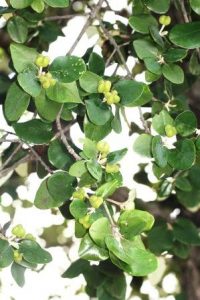
Androstachys johnsonii. Photo: Bart Wursten. Source: Flora of Zimbabwe
Of the 27 indigenous tree genera in the EUPHORBIACEAE only three have opposite leaves, Excoecaria. Androstachys and Mallotus. We examined Tom’s small specimen of Excoecaria madagascariensis from Mt. Selinda’s medium altitude forest. This confusing member does have a milky latex and stipules although these fall early. The minute specimen had already seeded so we saw the three lobed capsule. In the South East lowveld section we looked at the anomalous Androstachys johnsonii where the under side of the leaves is coated in the same wooly hairs that are so characteristic of the ASTERACEAE, although a daisy seldom has opposite leaves and rarely has stipules which are conspicuous on Androstachys. We also saw the trilocular, three chambered, fruit distinctive in the EUPHORBIACEAE. This tree of the South East mist belt grows in crevices and areas of extra moisture on the Nyoni Hills.
Alongside the Excoecaria also behind the Dracaena reflexa was Argomuellera macrophylla from Chirinda forest. It is found as a 2 m shrubby tree in the deep shade of Mt. Selinda. We saw the 3 capsuled fruit. Moving around to the Maranthes we saw last month we found a shrubby Neopalisia castaneifolia another shade loving EUPHORBIACEAE only known from the Valley of the Giants at Mt. Selinda.
Zig-zagging back we saw the Macaranga capensis with its distinctive peltate leaf. These are forest pioneers in the eastern highlands. The big stipules are noticeable. Erythrococca poliandra is a medium to high altitude plant from Inyangani.
Moving into the low altitude rainforest we saw the drip-tip on Cleistanthus apetalus. Tom refrained from slashing it with an axe to show the bright red lipstick under bark. C. apetalus grows on screes at low altitude near rivers in the east. Alongside it we noted an unidentified Uapaca sp. which apparently grows in water logged areas as if it was a freshwater mangrove, developing distinctive stilt roots under these conditions. Unlike Pamdanus these roots don’t develop in the Botanic Gardens. This tree grows in Malawi as well as the eastern slopes of the Chimanimanis.
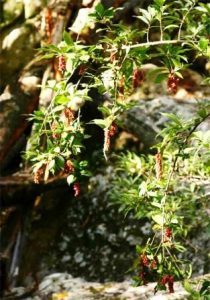
Antidesma venosum. Photo: Bart Wursten. Source: Flora of Zimbabwe
Croton megalabotrys grows with Faidherbia albidia on the low altitude river banks. We saw the typical Croton glands at the base of the leaf. Unlike the forest loving genus Drypetes, Croton has species that grow in a wide range of habitats.
Over the path from Ficus capreifolia is the Antidesma venosum one of the tassel berries that is widespread alongside the low altitude rivers. This tree shows another common EUPHORBIACEAE character, the leaves are often held out in one plane, a feature we have associated with the ANNONACEAE. Wondering around Meg’s garden recently we demonstrated how the two EUPHORBIACEAE stipules at the base of the petiole differentiates these two families that otherwise can be vegetatively identical. In some, the stipules fall early, such as in Pseudolachnostylis maprouneifolia.
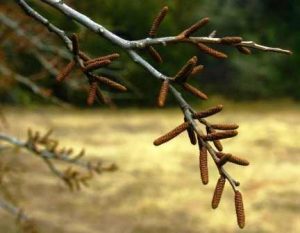
Spirostachys africana. Photo: Bart Wursten. Source: Flora of Zimbabwe
The tamboti of the S.E. Lowveld, Spirostachys africana grows along dry water courses. This tree has a fat trunk with lateral spurs and spikey growth. We noted the characteristic EUPHORBIACEAE fruit once again. Hymenocardia ulmoides also grows in the South East of Zimbabwe, usually as a low altitude forest edge species. Apparently it is very difficult to grow. Croton pseudopulchellus extends from the deep Cretaceous sands of the Gonarezhou to the Kalahari sands of Hwange, and south wards to Natal where it forms an important understory shrub in the dry sand forests with their characteristic deciduous canopy and evergreen understory.
All this emphasizes the wide diversity of the EUPHORBIACEAE, although it is interesting to note the family features that weave a number of disjointed threads through the group. Thank you Tom, we hope you were on time for your later appointment.
-Kim ST.J.Damstra
A.G.M. MATABELELAND BRANCH,DECEMBER 4TH 1983
CHAIRMAN’S REPORT : At our AGM last year the members voted to continue in spite of depleted number, especially among the more knowledgeable of us. Their decision has been justified. Our outings have been well attended and it is obvious that our small number is more than compensated for by the enthusiasm shown by everyone.
Our numbers were swelled on three occasions during the past year. The Haxens and Kim Damstra joined us on our outing to the Matopos, on a cold day I think it was in July, we had the pleasure of Meg Coates Palgrave’s company on an outing to the wilderness area of Hillside Dams and Val Deas brought along a posse of University Women in October when we took them to a kopje in the Douglasdale area which they seemed to enjoy and in which they took an intelligent interest.
Our movements are somewhat curtailed by the security situation which keeps us within the confines of Bulawayo. I feel we have thoroughly explored all the available areas nearer home and hope that someone at this meeting today will come up with some new ideas.
It concerns me that we are content to drift along very pleasantly, but I would like suggestions as to how we could ‘pep up’ the branch. Would you agree to re-introducing short talks on specified trees by members? When we did this some time ago I felt it was worthwhile although trees came to be known a “So and So’s tree”. At least the people who gave the talks remembered the tree about which they spoke forever and ever afterwards. Perhaps this can come up for discussion at this meeting.
It remains for me to thank you for your support and to wish you all a very happy Christmas and a Happy New Year as far as the sad state of the world allows!
The meeting decided unanimously to resume talks on trees given by members. They all felt this had been valuable and agreed that they enjoyed the research this entailed.
It also agreed that we must do something to learn the natural orders. This will entail quite a lot of work and study but is well worth the effort.
-Dora Webb
A.G.M. AYRSHIRE BRANCH
CHAIRMAN’S REPORT NOVEMBER 1982-1983 : The past year has not been a particularly active one for the Branch and a number of events proposed at the last AGM did not take place. In the early part of the year the petrol crisis restricted travel and deterred us planning outings.
The third National Tree Planting Day was on December 4th, various functions were held in the district. At Katawa, school children planted Acrocarpus and Toona ciliata trees beside their sports ground. At Raffingora the following trees were planted in the grounds of the Primary School; Acacia albida, A. galpinii, Celtis africana and Entada spicata. Mr. Frank de Toit gave a short talk in Shona to the assembled children. He stressed the necessity of ensuring that enough trees are planted and cared for to prevent the country turning into a wasteland. It was hoped that more indigenous trees will be planted in the school grounds in future years and that this will in turn create a greater awareness amongst the children of the tremendous variety and usefulness of our indigenous plants.
A selection of indigenous trees, mainly Acacias have been raised by Mr. Fourie and planted in the Ayrshire Rural Council Office grounds, these have shown remarkable growth during the year. The Sausage tree donated by Mrs. Coates Palgrave and planted in 1981 continues to thrive. On Sunday April 17th members and friends of the Branch visited Lone Cow Estate. A big thank you to the Fraser Mackensies for their hospitality and for arranging the programme.
On June 9th the one and only committee meeting took place, it was there that Branch members heard of the sudden death of Paul Coates Palgrave a few days previous. At this meeting Mr. Barron outlines clauses in the Forest Act as regards re-forestation on farms that have been denuded of timber. The Ken Fox Memorial Garden will be planted with a selection of Acacias as soon as the rains break.
July 17th. There was a combined outing with the Harare Branch to the Raphia Palm Botanical Reserve on Mawari farm in the Palm Block.
The last outing took place on July 28th, it was a midweek walk to a wooded kopje on S.S. Ranch which belongs to Mr. Malan.
It was unfortunate that it was not possible to arrange a field afternoon for farm employees as the one held the previous year had proved to be a success and was enjoyed by employees and participants alike.
The Branch membership remains at 22 members. In May Mr. Geoffrey Moore was honoured for his years of enthusiastic support by being awarded Hon. Life Membership of the Society, congratulations to Geoffrey on this very well deserved award.
That sums up the activities during the past year and thanks to Dicki Graves for the work and enthusiasm she has put into Branch affairs. Also thanks to Ian and Margaret Barron for being our hosts this afternoon.
PROPOSALS FOR 1984 AND THE FUTURE OF THE SOCIETY
Everyone agreed on the importance of more meetings, quarterly, and more midweek local outings. “Keep trying” were the key words, although attendance may be small interest would be kept alive and lead on to the next event.
Mrs. Malan endorsed the Dichwe visit, Mrs. Duffield said Darwendale Dam should be worth seeing, an exchange visit Ayrshire/Chegutu was mooted. Mr. Fernsby offered to field an afternoon outing to see his selective woodcutting on Kelston farm. He selects Brachystegia boehmii, B. allenii and Bauhinia for fuel because these species coppice readily. A demonstration on Tree Planting with instructions in Shona will be arranged for employees when the weather allows.
ELECTION OF OFFICERS
Mr. Fourie told members that he was prepared to remain in the Chair. Relief, relief. Office holders for 1983/1984 are as follows
Mr. S. Fourie Chairman
Mrs. G. Henderson Secretary
Mrs. E. R. Jones
Mrs. M. Malan
Mr. A. Duffield
Mrs. B. Graves
Mr. I. Barron
Mr. N. Fernsby
Members agreed that this large Committee would benefit the Branch. Mrs. Graves was grateful to the Chairman and members for allowing her a breather from duties of Secretary. She thanked everyone for their acclaim concerning her award of the gemstone Msasa tree Trophy presented by Mrs. E. R. Jones. This honour and wonderful encouragement was totally unexpected.
ROOT NOTE John Rushworth of the Department of Biological Sciences at the University of Zimbabwe displayed some results recently that I thought bear repeating. He has been working in the Kalahari Sands of Hwange National Park. “Large areas of deep, infertile Kalahari sand in Western Zimbabwe are carpeted with a dense woody shrub community one to four meters tall, and are often regarded as of little use to man or the larger herbivores”. In fact only about 2% is silt and clay. A rich soil of volcanic origin also within the National Park is known as a basalt vertisol and contains 91% silt and clay. This difference is important because many nutrients that are washed away in sand will cling onto the tiny clay particles and therefore will be available to the plants. To sidetrack for a while this is one reason why termitaria are often so rich in nutrients. The termites collect all the clay and silt from the surrounding area and pack it into their nest. This helps change the nutrient status so dramatically that we cannot fail to notice the differences between vegetation on the termitarium and off it. To get back to the Kalahari Sands they do have a low level of nutrients. But coarse sand does have an advantage. Kalaharis usually use a high proportion of sand in seed trays to encourage rooting. Kalahari Sand is an excellent rooting medium. Many trees develop an extensive root system in the 30 m deep sands. The rain water is quickly absorbed into the sand where it is available to the roots. Many of the trees are legumes such as Baphia massaiensis, Acacia fleckii and the teak Baikiaea plurijuga and can increase the nutrient status be means of nitrogen fixing bacteria in their roots. Other Kalahari plants besides these can also fix nitrogen. Dr. Rushworth investigated the availability of food to animals during various parts of the year, especially by comparing grasses and woody shrubs. He found that at the height of the dry season, before the rain, the deep rooted trees flushed out in new growth which had a moisture content of 68% compared to the grass water content of 20%. There was also much more browse available. The crude protein of the perennial grasses at this time of the year ranged from 4 to 6% whereas in the shrubs it ranged from 19 to 26% – rather significant. The one exception was Lonchocarpus nelsii which had 39% crude protein in the leaves in September. “Of the plants listed Terminalia sericea and Baikia plurijuga, teak, are not as favoured by the wild herbivore browsers, including elephant giraffe, eland, kudu, impala, steenbok and duiker, as the remaining species, Baphia massaiensis, Bauhinia petersiana subsp. serape, Combretum collinum, Pterocarpus angolensis C. zeyheri, Lonchocarpus nelsii and Ochna pulchra. Bearing in mind the high quality of this leaf material, a good stock of valuable food is available in this shrub community particularly during the dry August to November period when the grass layer is both low in quality and quantity”. John goes on to conclude : “The high quality of woody shrub leaf material produced under arid conditions on infertile Kalahari Sands in Western Zimbabwe is nothing short of remarkable. Many wild herbivores, particularly the browsers, thrive on this source of high quality food available in large areas of the Kalahari sand region of Hwange National Park. Provision of permanent water supplies is often the only management aid required. It is apparent that there are vast untapped stores of valuable food available in the leaves of many woody shrubs of the ‘bushy/scrubby’ areas of Zimbabwe for both domestic and wild herbivores. Simple management practices can make much of this food energy available, particularly during the critical dry August to November period when natural grass stocks are low in both bulk and quality. The discovery that two apparently ‘useless grazing grasses’ Eragrostis spp. play a role in vital atmospheric nitrogen fixation must surely make one more hesitant in the future to arbitrarily proclaim that any particular plant is of no use. We often know so very little about the life histories and real value of our indigenous plants. The woody species of the Kalahari sand shrub community appear to represent equilibrium species, expending energy in the building up of massive underground rootstocks or other storage organs which give them the advantage in long term survival. This particular ecosystem is remarkably resilient to above ground damage and it represents both a very stable and valuable resource”. Quotations from Rushworth, J. E., 1978, Wankie National Park Notes No. 20, 8pp.
-Kim ST.J.Damstra
ROOTNOTES : An interesting historical note on the use of Commiphora wood comes from Dr. Phelps of the University of Zimbabwe. Apparently in the north east of the country where the Mazowe River flows into Mozambique in the Nkota Reserve a number of villages failed to join the 1896 uprisings and so were allowed to keep their old muzzle loaders. Dr. Phelps reports watching them make their own gunpowder. At the base of the Umbaga Hill a nitrogenous salt percolates upwards in the ground water and crystallizes out on the surface when the water evaporates. The salts are scraped off the sand. This mixture may be further purified by dissolving the salt in water and filtering through a grass mat to remove the sand. The water is then allowed to evaporate in the sun.
This salt is ground with charcoal made from a specific Commiphora wood. The resultant mixture forms gunpowder that is apparently fairly successful. A similar method using dried dassie urine as the nitrogenous source is also used.
-Kim ST.J. Damstra
ROOTNOTE: Our Treasurer, Brian Best, informs us of yet another name change. Our old friend Canthium huileense is now Psydrax livida, and that will take some getting used to.
PHIL HAXEN CHAIRMAN.


